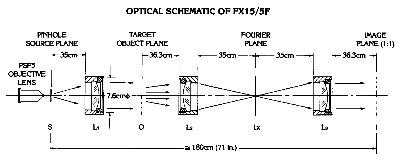|
 The FX l5/5F Fourier Transform System meets the needs of the experimentalist on a very limited budget with a unique combination of hardware and software for a wide variety of applications. Economically priced, it is complemented by a Manual of 16 Articles /Experiments with test data and illustrations including Fourier Transform photos obtained with these lenses. The FX l5/5F Fourier Transform System meets the needs of the experimentalist on a very limited budget with a unique combination of hardware and software for a wide variety of applications. Economically priced, it is complemented by a Manual of 16 Articles /Experiments with test data and illustrations including Fourier Transform photos obtained with these lenses.
Applications
Computer generated holography.
Hybrid Computer-Controlled Optical Correlator for Multiple Target Recognition.
Optical-data processing/Liquid-Crystal television spatial light modulator.
Acousto-optic space integrating correlator.
Color encoding of holographic interferometric fringe patterns with white-light processing
Coherent optical implementation of generalized two-dimensional transforms.
The system contains 1 Collimator and 2 Fourier lenses: 7.6cm diameter, f/5; 32 lines/mm resolution and lambda/8 wavefront accuracy over central 3.8cm aperture; lenses assembled in cells tapped for easy mounting Pinhole spatial filter with 40X objective lens and 10 micron removable, magnetically-held pinhole; will accept standard microscope objective lenses; micrometer drives provide smooth, precise, displacement of lens along stainless steel dual rails 63-page Text/Manual.
System Operation: Pinhole Spatial Filter takes collimated laser beam and provides diverging output cone via precision X, Y, & Z micrometers, which align 40X objective lens precisely with 10 micron pinhole. Pinhole becomes noise-free source plane. Collimator Lens, and two Fourier Lenses, which are of achromatic-doublet design, selectively tested for performance at 0.6328 micron, helium-neon, with even higher resolution at 0.4880 micron, argon. Optimum system performance results when all lenses are precisely aligned. The Collimator, located a focal length distance from the pinhole, presents a parallel light bundle to the object/target to be transformed. Fourier Lens, then transforms the object information at the Fourier transform plane. The selection and use of an appropriate filter retransforms the filtered object through the lens to the image plane, essentially the recording plane.
NOTES:
1. Detailed procedure with sketches for system alignment is described, including optimized objective/pinhole chart for various laser wavelengths.
2. A "Boys Point" method of lens alignment is described.
3. For improved image enhancement, a Liquid Gate is recommended to sandwich the target firmly between two precision-polished optical windows within an index-matching liquid, normal to the optical axis. Errors associated with film grain are removed by this technique.
4. One complete Manual chapter is devoted to classical Fourier transforms of various objects.
5. A 4x5 inch Polaroid Graflok camera back, or standard 35mm camera back, less lens, may be conveniently used; the former for time-saving exposures.
|
 The FX l5/5F Fourier Transform System meets the needs of the experimentalist on a very limited budget with a unique combination of hardware and software for a wide variety of applications. Economically priced, it is complemented by a Manual of 16 Articles /Experiments with test data and illustrations including Fourier Transform photos obtained with these lenses.
The FX l5/5F Fourier Transform System meets the needs of the experimentalist on a very limited budget with a unique combination of hardware and software for a wide variety of applications. Economically priced, it is complemented by a Manual of 16 Articles /Experiments with test data and illustrations including Fourier Transform photos obtained with these lenses.